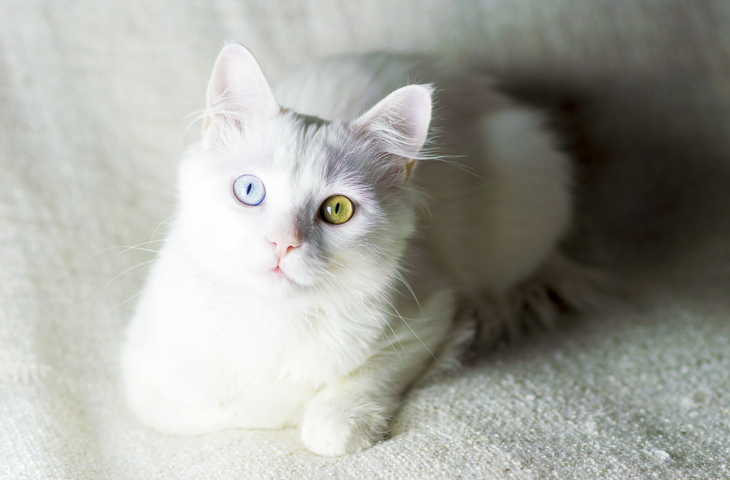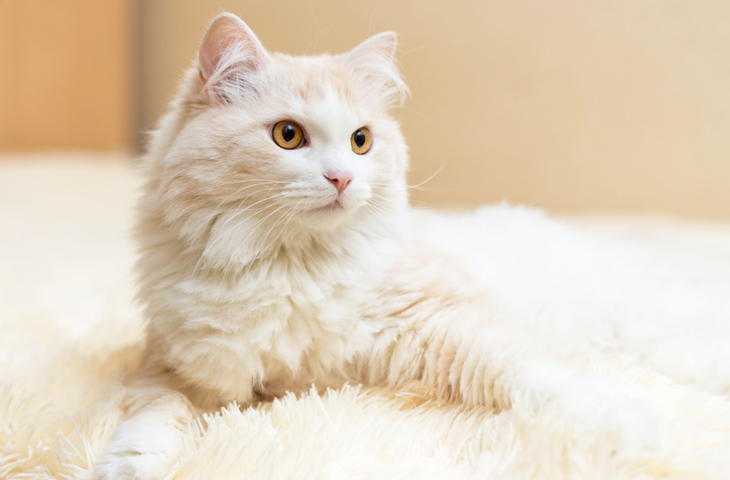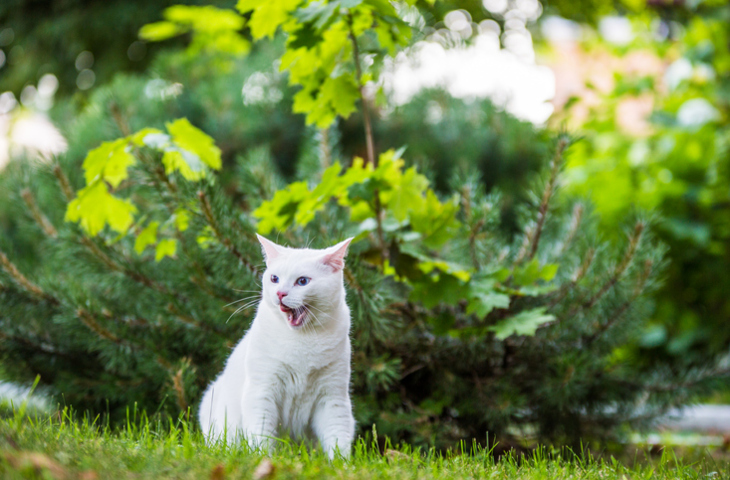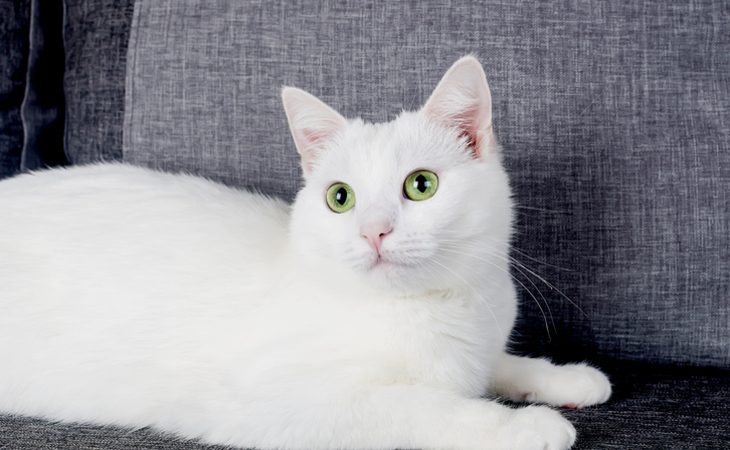Breed standard: CFA, FIFe, TICA, ACFA/CAA, CCA-AFC | Size: Medium | Average lifespan: 13+ years | Temperament: Playful and independent | Coat: Medium-long/long | Origin: Turkey.
Originating from Turkey, the Turkish Angora is an elegant cat characterized by its long, silky coat and lack of an undercoat. They have medium-long to long hair and a fine and slender silhouette.
The Turkish Angora’s origins
An aristocratic cat
For over 2,000 years, the Turkish Angora has been appreciated for its elegance. The breed originated in Turkey, a country found in both Europe and Asia. While the Turkish Angora’s name suggests that it originates solely from Turkey, it also came from surrounding countries such as Iran and Syria. In the past, white Turkish Angoras were mostly owned by rich merchants. Back then, they were seen as a symbol of wealth, purity, and finesse.
Fun fact: it was the first long-haired breed to arrive in Europe. The first European Turkish Angora breeder was a French naturalist named Fabri. He brought a few Turkish Angora cats back with him to Europe. Back then, the Turkish Angora was highly appreciated by the European aristocracy, especially in France. For example, Richelieu had fourteen of them, Louis XVI, Louis XIII, and Marie-Antoinette also had a few. According to legend, Marie-Antoinette sent her Turkish Angoras to the Americas before her arrest. It is believed that this is how the breed arrived in the New World.
The Turkish Angora in the 20th century

The Turkish Angora was also very popular in England. Many crosses between the Turkish Angora and British Shorthair took place in the 19th century. Through these crosses, the Persian cat breed was created. The Persian cat was a great success and stole the show from the Turkish Angora. After the Second World War, the breed almost disappeared. In an effort to protect the breed, the Turks decided to place some of these cats in the zoo in Ankara, the capital of Turkey.
European and American breeders imported Turkish Angoras from Turkey in the middle of the 20th century. It wasn’t until the 1970s that the Turkish Angora found real success. The first Turkish Angoras were registered by the Cat Fanciers’ Association in 1970 and it was recognized in 1973. In 1988, the Turkish Angora was recognized by the Fédération Internationale Féline (International Cat Federation in English).
Currently, the Turkish Angora is relatively unknown. Its main “competitors” are more recent long-haired breeds such as the Norwegian Forest Cat, the Siberian cat, the Maine Coon, the Persian cat, and others.
This cat breed is still protected in the Ankara Zoo. In addition, this cat breed is still exported to cat breeders around the world.
What does a Turkish Angora look like?
The Turkish Angora standard was defined following the first cat show held in England in the late 19th century. Turkish Angoras bred today are finer and more elegant than the cats of the Ankara Zoo. Their ears are also larger and higher set.
Head
Small to medium and triangular, the head of the Turkish Angora is harmonious. The head is slightly refined towards the chin. From the profile view, we can distinguish two straight lines. One goes from the top of the head to the eyes. The other line goes from the eyes to the nose. Slightly rounded, the muzzle is rather long. When it comes to the nose, it is of average size. As for the eyes, they are large and almond-shaped. They are very expressive. The first Turkish Angoras had blue eyes, some even had one blue eye and the other eye either green or orange. The Turkish Angora’s iconic large ears are wide at the base and end with a slight point. Hair points out from the end of the ears like a lynx.
Body
The Turkish Angora is known for its graceful and elegant appearance. Their medium-sized body is long, slender, and muscular. Despite its light bone structure, this cat breed appears larger because of its thick fur. The average cat weighs between 2.5 and 5 kg (4 to 11 lbs). Males are larger than females. The legs and body are well proportioned and the hind legs are longer than the front legs. This cat’s tail is proportional to the rest of the body. It is long and feathery like an ostrich feather.

Coat
This cat breed’s coat is medium-long and it does not have an undercoat. The fur is very soft and silky. On the collar, the breeches, and under the belly, the fur is longer and thicker. Turkish Angoras do not start developing hair around the collar until they reach a year old. The fur around the collar will usually take its final shape after about two winters.
What color is the Turkish Angora’s coat?
Lilac, cinnamon, chocolate, fawn, as well as patterns such as sepia, mink, and colorpoint, are the only colors and patterns refused by the Livre Officiel des Origines Félines (Official Book of Feline Origins in English) and the Fédération Internationale Féline (International Cat Federation in English). Every other color is accepted. The most emblematic color of the Turkish Angora has always been white. This explains why some associations have been slow to recognize other colors. Over time, cats of different colors have been recognized, but the white Turkish Angora with blue eyes is still the most well-known. It should be noted that some white coats have small gray spots above the head and between the ears.
The Turkish Angora’s personality

The Turkish Angora is an independent cat breed that likes its freedom. It knows how to handle being alone. This cat breed is curious, interested in new things, and likes to go to discover new horizons. It has a strong personality and is very playful. The Turkish Angora likes to play with everything it can find. This is especially the case with water. In addition, this cat breed is known to be joyful and lively. They like to spend time with humans. They also love to stay with their owners and ask for cuddles every day.
Does this cat breed get along with others?
The Turkish Angora is solitary and likes to be the only animal in the house. Nevertheless, this cat can live quite well with other animals. They get along well with dogs and other cats, but they should be introduced slowly and properly. Your house should enough places for your Turkish Angora to rest quietly. This cat also likes spending time with children. They typically have more time to take care of them and this cat particularly appreciates this. With that in mind, it is important to educate children on how to respect cats and how to understand a cat’s body language. The Turkish Angora cat also likes to live with the elderly, provided that the environment is stimulating enough to satisfy its curiosity.
Caring for a Turkish Angora
Other than a weekly brushing, the Turkish Angora does not require particular care. During their summer molting period, it is especially important. Brushing will help preserve the shine and lightness of their fur.
Regarding their diet, it is important to offer this cat food that is rich in fiber. This will reduce the risk of digestive problems. It should be noted that this cat is particularly fond of kibble and wet food.
Did you know?
This cat is considered a national treasure in Turkey. Their elegant appearance makes them look like dancers.
The Turkish Angora at a glance
Size: 30 cm.
Weight: 3 kg to 4 kg (6 to 9 lbs) for females and up to 5 kg (11 lbs) for males.
Health: This cat is relatively healthy and rarely gets sick. However, early deafness is therefore common in the Turkish Angora.
Average lifespan: 13 to 16 years.
Is the Turkish Angora good with children? This cat is very affectionate. They like attention and enjoy playing with and being pet by children

